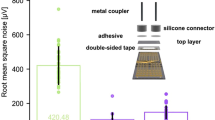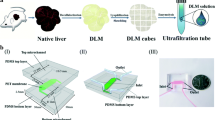Abstract
Mechanical stress has been proven to be an important factor interfering with many biological functions through mechano-sensitive elements within the cells. Despite the current interest in mechano-transduction, the development of suitable experimental tools is still characterized by the strife to design a compact device that allows high-magnification real-time imaging of the stretched cells, thus enabling to follow the dynamics of cellular response to mechanical stimulations. Here we present a microfluidic multi-layered chip that allows mechanical deformation of adherent cells maintaining a fixed focal plane, while allowing independent control of the soluble microenvironment. The device was optimized with the aid of FEM simulation and fully characterized in terms of mechanical deformation. Different cell lines were exposed to tunable mechanical strain, which results in continuous area deformation up to 20%. Thanks to the coupling of chemical glass etching, 2-dimensional deformation of a thin elastomeric membrane and microfluidic cell culture, the developed device allows a unique combination of cell mechanical stimulation, in line imaging and accurate control of cell culture microenvironment.







Similar content being viewed by others
References
Ahmed, W. W., T. Wolfram, A. M. Goldyn, K. Bruellhoff, B. A. Rioja, M. Möller, J. P. Spatz, T. A. Saif, J. Groll, and R. Kemkemer. Myoblast morphology and organization on biochemically micro-patterned hydrogel coatings under cyclic mechanical strain. Biomaterials 31:250–258, 2010.
Alioscha-Perez, M., C. Benadiba, K. Goossens, S. Kasas, G. Dietler, R. Willaert, and H. Sahli. A Robust actin filaments image analysis framework. PLOS Comput. Biol. 12:e1005063, 2016.
Amaya, R., A. Pierides, and J. M. Tarbell. The interaction between fluid wall shear stress and solid circumferential strain affects endothelial gene expression. PLoS ONE 10:e0129952, 2015.
Antunes, M., T. Pereira, J. V. Cordeiro, L. Almeida, and A. Jacinto. Coordinated waves of actomyosin flow and apical cell constriction immediately after wounding. J. Cell Biol. 202:365–379, 2013.
Aragona, M., T. Panciera, A. Manfrin, S. Giulitti, F. Michielin, N. Elvassore, S. Dupont, and S. Piccolo. A mechanical checkpoint controls multicellular growth through YAP/TAZ regulation by actin-processing factors. Cell 154:1047–1059, 2013.
Balachandran, K., P. W. Alford, J. Wylie-Sears, J. A. Goss, A. Grosberg, J. Bischoff, E. Aikawa, R. A. Levine, and K. K. Parker. Cyclic strain induces dual-mode endothelial mesenchymal transformation of the cardiac valve. Proc. Natl. Acad. Sci. USA 108:19943–19948, 2011.
Chang, Y. J., C. J. Tsai, F. G. Tseng, T. J. Chen, and T. W. Wang. Micropatterned stretching system for the investigation of mechanical tension on neural stem cells behavior. Nanomed. Nanotechnol. Biol. Med. 9:345–355, 2013.
Chiquet, M., and M. Flück. Chapter 8 Early responses to mechanical stress: from signals at the cell surface to altered gene expression. In: Cell and Molecular Response to Stress, edited by K. B. Storey, and J. M. Storey. Amsterdam: Elsevier, 2001, pp. 97–110.
Dai, G., M. R. Kaazempur-Mofrad, S. Natarajan, Y. Zhang, S. Vaughn, B. R. Blackman, R. D. Kamm, G. García-Cardeña, and M. A. Gimbrone. Distinct endothelial phenotypes evoked by arterial waveforms derived from atherosclerosis-susceptible and -resistant regions of human vasculature. Proc. Natl. Acad. Sci. 101:14871–14876, 2004.
Formigli, L., E. Meacci, C. Sassoli, R. Squecco, D. Nosi, F. Chellini, F. Naro, F. Francini, and S. Zecchi-Orlandini. Cytoskeleton/stretch-activated ion channel interaction regulates myogenic differentiation of skeletal myoblasts. J. Cell. Physiol. 211:296–306, 2007.
Giobbe, G. G., F. Michielin, C. Luni, S. Giulitti, S. Martewicz, S. Dupont, A. Floreani, and N. Elvassore. Functional differentiation of human pluripotent stem cells on a chip. Nat. Methods 12:637–640, 2015.
Giulitti, S., A. Zambon, F. Michielin, and N. Elvassore. Mechanotransduction through substrates engineering and microfluidic devices. Curr. Opin. Chem. Eng. 11:67–76, 2016.
Gudipaty, S. A., J. Lindblom, P. D. Loftus, M. J. Redd, K. Edes, C. F. Davey, V. Krishnegowda, and J. Rosenblatt. Mechanical stretch triggers rapid epithelial cell division through Piezo1. Nature 543:118–121, 2017.
Ishida, T., M. Takahashi, M. A. Corson, and B. C. Berk. Fluid shear stress-mediated signal transduction: how do endothelial cells transduce mechanical force into biological responses? Ann. N. Y. Acad. Sci. 811:12–23, 1997.
Johnston, A. P. W., J. Baker, M. D. Lisio, and G. Parise. Skeletal muscle myoblasts possess a stretch-responsive local angiotensin signalling system. J. Renin Angiotensin Aldosterone Syst. 12:75–84, 2011.
Kamble, H., M. J. Barton, M. Jun, S. Park, and N.-T. Nguyen. Cell stretching devices as research tools: engineering and biological considerations. Lab. Chip 16:3193–3203, 2016.
Kosmalska, A. J., L. Casares, A. Elosegui-Artola, J. J. Thottacherry, R. Moreno-Vicente, V. González-Tarragó, M. Á. del Pozo, S. Mayor, M. Arroyo, D. Navajas, X. Trepat, N. C. Gauthier, and P. Roca-Cusachs. Physical principles of membrane remodelling during cell mechanoadaptation. Nat. Commun. 6:7292, 2015.
Kumar, A., R. Murphy, P. Robinson, L. Wei, and A. M. Boriek. Cyclic mechanical strain inhibits skeletal myogenesis through activation of focal adhesion kinase, Rac-1 GTPase, and NF-κB transcription factor. FASEB J. 18:1524–1535, 2004.
Maul, T. M., D. W. Chew, A. Nieponice, and D. A. Vorp. Mechanical stimuli differentially control stem cell behavior: morphology, proliferation, and differentiation. Biomech. Model. Mechanobiol. 10:939–953, 2011.
McCain, M. L., and K. K. Parker. Mechanotransduction: the role of mechanical stress, myocyte shape, and cytoskeletal architecture on cardiac function. Pflüg. Arch. Eur. J. Physiol. 462:89, 2011.
Michielin, F., E. Serena, P. Pavan, and N. Elvassore. Microfluidic-assisted cyclic mechanical stimulation affects cellular membrane integrity in a human muscular dystrophy in vitro model. RSC Adv. 5:98429–98439, 2015.
Nakai, N., F. Kawano, Y. Oke, S. Nomura, T. Ohira, R. Fujita, and Y. Ohira. Mechanical stretch activates signaling events for protein translation initiation and elongation in C2C12 myoblasts. Mol. Cells 30:513–518, 2010.
Prosser, B. L., R. J. Khairallah, A. P. Ziman, C. W. Ward, and W. J. Lederer. X-ROS signaling in the heart and skeletal muscle: stretch-dependent local ROS regulates [Ca2+]i. J. Mol. Cell. Cardiol. 58:172–181, 2013.
Ruder, W. C., E. D. Pratt, N. Z. D. Brandy, D. A. LaVan, P. R. LeDuc, and J. F. Antaki. Calcium signaling is gated by a mechanical threshold in three-dimensional environments. Sci. Rep. 2:554, 2012.
Salameh, A., A. Wustmann, S. Karl, K. Blanke, D. Apel, D. Rojas-Gomez, H. Franke, F. W. Mohr, J. Janousek, and S. Dhein. Cyclic mechanical stretch induces cardiomyocyte orientation and polarization of the gap junction protein connexin43. Circ. Res. 106:1592–1602, 2010.
Shannon, E. K., A. Stevens, W. Edrington, Y. Zhao, A. K. Jayasinghe, A. Page-McCaw, and M. S. Hutson. Multiple mechanisms drive calcium signal dynamics around laser-induced epithelial wounds. Biophys. J. 113:1623–1635, 2017.
Shyy, J. Y.-J., and S. Chien. Role of integrins in cellular responses to mechanical stress and adhesion. Curr. Opin. Cell Biol. 9:707–713, 1997.
Suchyna, T. M., and F. Sachs. Mechanosensitive channel properties and membrane mechanics in mouse dystrophic myotubes. J. Physiol. 581:369–387, 2007.
Tulloch, N. L., V. Muskheli, M. V. Razumova, F. S. Korte, M. Regnier, K. D. Hauch, L. Pabon, H. Reinecke, and C. E. Murry. Growth of engineered human myocardium with mechanical loading and vascular coculture. Circ. Res. 109:47–59, 2011.
Vindin, H., L. Bischof, P. Gunning, and J. Stehn. Validation of an algorithm to quantify changes in Actin Cytoskeletal Organization. J. Biomol. Screen. 19:354–368, 2014.
Yeung, E. W., and D. G. Allen. Stretch-activated channels in stretch-induced muscle damage: role in muscular dystrophy. Clin. Exp. Pharmacol. Physiol. 31:551–556, 2004.
Acknowledgment
This research was supported by Progetti di Eccellenza CaRiPaRo, Oak Foundation Award (Grant #W1095/OCAY-14-191) and TRANSAC Progetto Strategico Universitá di Padova. This research was supported by the NIHR GOSH BRC. The views expressed are those of the author(s) and not necessarily those of the NHS, the NIHR or the Department of Health.
Author information
Authors and Affiliations
Corresponding author
Additional information
Associate Editor Peter E. McHugh oversaw the review of this article.
Electronic supplementary material
Below is the link to the electronic supplementary material.
Rights and permissions
About this article
Cite this article
Prevedello, L., Michielin, F., Balcon, M. et al. A Novel Microfluidic Platform for Biomechano-Stimulations on a Chip. Ann Biomed Eng 47, 231–242 (2019). https://doi.org/10.1007/s10439-018-02121-z
Received:
Accepted:
Published:
Issue Date:
DOI: https://doi.org/10.1007/s10439-018-02121-z




